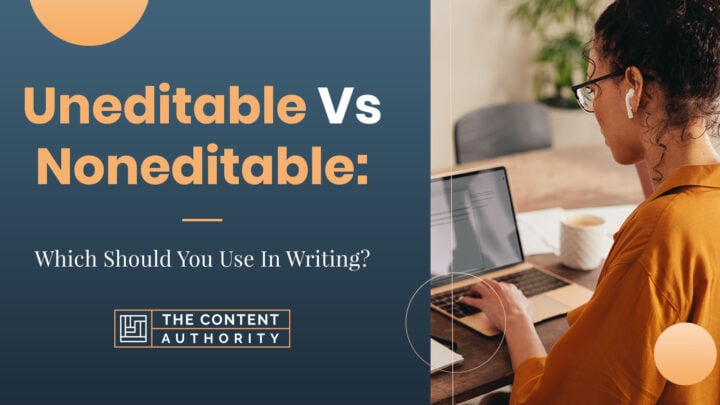-Non and -Un are two prefixes that indicate a negative meaning, but there are grammatical rules on how to attach them to words. While they may also be used interchangeably for some words without taking away the intended meaning, your computer will display the typical red error line underneath the inappropriate word when used incorrectly. To avoid that when writing, this article will differentiate the words “uneditable” and “noneditable,” and you will learn how to use them correctly.
“Uneditable” is the word to use when you are saying that a document or text cannot be altered, modified, or edited. “Noneditable” is the opposite of an editable work. “Un-” is also a suitable prefix to describe something that cannot be edited permanently, but it is not as recognized.
Whether you are a native or non-native English speaker, it is best to understand a word before using it in a sentence. You must also learn the right prefix to know which article goes best with it. The summary is that “uneditable” and “noneditable” are computing terms and don’t often refer to words written with a pen on paper.

What do the Words “Uneditable” and “Noneditable” Mean?
To start with, un- and non- are used in different contexts to convey different meanings. -un is the harsher version between the two prefixes “-un” and “-non,” which depict a negative result or quality. There are uses for each prefix, but we do not have to go into that. What you need to know is the right one for your text.
Now that you know the right prefix, let us define each word and examine the etymology. The definition helps you confirm that you are on the right path, while the etymology will come in handy when next you doubt the right option to use. Etymology explains the origin of a word. It is the history of how the word evolved and developed its current spelling and meaning.
Let’s start with “uneditable.”We will break it down into various components because “uneditable” is not technically a single word.
The composition includes: “Un-,” “-edit,” and “-able.” “un-” originated from the period after the Norman conquest, which ended in the 15th century. The English spoken then was called Middle English. -un indicates the absence of a quality or effect. It could also mean something is contrary to another thing.
“-edit” is an abbreviation of the word “editor,” They both originate from medieval Latin and Late Latin. To “edit” means to modify something in a document or paper. It has different uses, but in computing, the word “edit” means to make changes to a text or file.
“-able” has Middle English and Old Northern French origins. It also has a slight Latin history, meaning having the power to make something happen. The word indicates a quality of being free of restrictions from completing a task.
Now, let’s apply the word’s etymology to the definition and also consider some synonyms.
The word “uneditable” means lacking the ability to be changed or modified, and not temporarily.” The synonyms include inalterable, unchangeable, and view only.
You will often use “uneditable” as a computer-related term. This is when you want to say that a document, text, or file cannot be altered. It is in an unchangeable condition, which means you can read only.
You say something is uneditable, referring to content that an unauthorized party cannot alter. A Google Doc link leads to an uneditable page until you are granted permission to make changes. It is often “uneditable” because it has been made so by the owner or programmer of the application.
On the other hand, use “noneditable” when describing a document, text, or file to which users are not allowed to make alterations, but this is not the permanent state of the document, text, or file.
The etymology of “noneditable” is similar to “uneditable,” the difference being the prefixes.
“Non-“ is a middle English word that depicts a “lack of,” “a missing quality or effect,” or the inability or failure to achieve a state. You can use it for nouns and adjectives.
“Noneditable” is an adjective describing a document available for reading only. This application is directed at users and viewers only, but there is a group with access to its editable version. “Noneditable” can be used interchangeably with “uneditable,” but you will find “noneditable” in the dictionary as the right way to describe an unalterable quality.
When Should You Use Them in Writing?
You can use “noneditable” when describing a document that a viewer cannot make changes to. You can also use it to mean something that cannot be altered. It is view-only. “Noneditable” depicts that the document, file, or text owner can make necessary changes, but you can’t.
In writing, it is better to seek reassurance when unsure of the right word or spelling. “noneditable” is the more recognized word to describe a text that encourages viewership but no alteration.
For instance, you can say that your virtual college application form is noneditable. You are supposed to view it, enter the required details to fill in the missing link, and submit. That is all.
“Uneditable” can also be used to describe the same. However, the document leaves the readers or viewers with absolutely no means or hope of ever editing the document.
They are used interchangeably, but “noneditable” is the recognized version. “Uneditable” is just a fairly acceptable variant that you certainly should avoid using in formal writing.

Examples Of the Words Uneditable” and “Noneditable” In Sentences
The acceptable spelling is “noneditable.” Use this when writing texts on computers and paper. You may be more lenient when speaking since speech laws differ from those guiding written grammar. Still, check out these examples of “noneditable” real quick:
- The questions on the google form are usually noneditable. Unless you want to create a survey of your own, you will have to provide the answers needed in the compulsory sections.
- The invigilator was quite stern. He made it so that the moment the entire sixty minutes allocated to the entrance examination lapsed, the pages became noneditable.
- Some parts of the Microsoft Word Application are noneditable. This means the two nerds could make no alterations to them, no matter how hard they tried.
- If eBooks did not have a noneditable feature, many would easily plagiarize and create their own stories from the work of others.
- The Principal calmly and patiently explained to the parents of the students with bad second-year CGPAs that their results were noneditable.
- The signature of the CEO turned out to be noneditable even on paper, no matter how hard the hooligans in his organization tried to alter it. It was indeed unique and very well crafted to be that way.
- Every intellectual write-up is legally noneditable. The opposite of this would be plagiarism.
- Ibrahim, the new clerk at Bake-and-Eat, tried to steal money from his employer by attempting to modify the receipts. But it turned out that the software employed a noneditable interface.
- After the robbers stole the laptop containing the unpublished manuscript from the deceased New York bestselling writer’s penthouse, they discovered that the file was noneditable.
- The agent sent a noneditable copy of his writer’s screenplay, but it was turned away because there were no means to improve the content.
Other Word Usage Posts
Final Thoughts
“Uneditable” vs. “noneditable,” we bet you know the appropriate one to use now. There is no need to second-guess yourself now that you are familiar with the word and how to use it. Your English professor will accept “noneditable” in text, and you may get away with using “uneditable” while communicating verbally, but the former is generally more acceptable than the latter.
Shawn Manaher is the founder and CEO of The Content Authority. He’s one part content manager, one part writing ninja organizer, and two parts leader of top content creators. You don’t even want to know what he calls pancakes.

